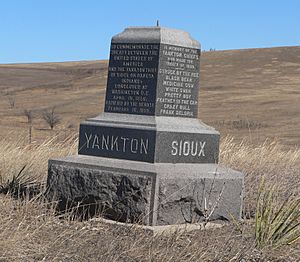Yankton Treaty facts for kids

The Yankton Treaty was an important agreement made in 1858. It was signed between the United States government and the Yankton Sioux (Nakota) Native American tribe. Through this treaty, the Yankton Sioux gave up a huge amount of land. This land was about 11 million acres in eastern South Dakota.
The treaty was officially signed in April 1858. The United States Congress then approved it on February 16, 1859. This approval meant the agreement was now law. Once approved, the land was opened up for new settlers, mostly white people. This led to people trying to set up their own local rules, even though the government in Washington, D.C., didn't officially recognize them yet. The treaty also set aside a special area of land for the Yankton Sioux. This area was called the Yankton Sioux Reservation. It was about 430,000 acres and is in what is now Charles Mix County, South Dakota.
Contents
Why Was the Treaty Signed?
The Yankton Treaty was signed because many white settlers were moving into the area. The United States government wanted to make it official for these settlers to live there. This was part of a larger plan to expand the country westward.
Leaders and Their Views
Two important leaders of the Yankton Sioux tribe had different ideas about the treaty.
Smutty Bear's Concerns
One chief, Smutty Bear (Ma-to-sa-be-che-a), did not want the treaty to happen. He believed that giving up land would only cause more problems. He thought it would lead to white settlers taking even more control.
Strike-the-Ree's Decision
Another elder chief was Strike-the-Ree (Pa-le-ne-a-pa-pe). He was also known as "The Man that Struck the Ree." He agreed that too many white people were moving onto their lands. However, he felt that trying to stop them would not work. Because of this, he decided to sign the treaty.
The Role of Charles F. Picotte
Charles F. Picotte was a person who worked as a translator during the meetings. He helped the Yankton Sioux and the U.S. government understand each other. He was also involved in business and land deals. For his help, the government gave him a large piece of land. This land was 640 acres in the new territory. This area later became a big part of the city of Yankton, South Dakota.

